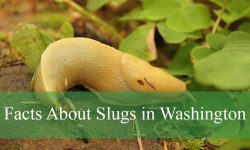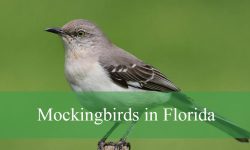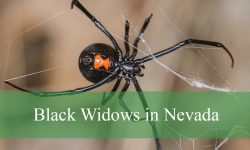In the sunny landscape of Florida, we often encounter Huntsman spiders somewhere. Known for their impressive size, distinctive features and occasional appearance in unexpected angles, this spider has become a subject of curiosity and for some people. Embarking on a journey to understand the intricacies of Florida’s huntsman spider, we delve into the realm of its habitat, behavior and unique attributes that make it a component of the ecosystem Florida’s diversity.
From its flat body to the complexity of its leg patterns, join us in unraveling the mysteries of this spider of the Sunshine State in this article.
A quick overview of Huntsman Spiders in Florida
The Huntsman spider (Giant Crab Spider), often referred to as a crab spider or banana spider, is well-known for having incredibly long legs that greatly increase its overall size. Even with its small body, the Huntsman spider can reach a maximum distance of five inches with ease.
These spiders are found in many parts of the planet, and they have lately been observed in Florida, Hawaii, California, and Texas, among other places. They seem to favor cramped, dark, and cozy environments.
When it comes to their activity, Huntsman spiders usually hide in grass, bushes, and cracks, but they have also been known to enter cars and houses. They move quickly and hold firmly to objects to keep from being swept away. They are skilled at finding cover and pursuing prey because of their agility.
How does a Florida Huntsman Spider look?
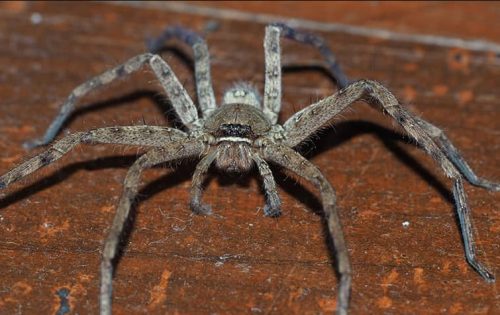
The huge, brown huntsman spider has a flattened body and few dorsal markings. Males are smaller than females when they are adults, but solely in terms of body size. Men are the largest in terms of leg size. They have dark patterns on their brown bodies.
There are unique black dots on every leg. These spiders are entirely smooth rather than hairy.
What kind of habitat does the Florida Huntsman Spider inhabit?
The most common places to find huntsman spiders in Florida are under boards, in sheds, barns, and other covered spaces. They cannot survive outside in areas with bitterly cold winters since they are cold-sensitive.
Today, huntsman spiders are commonly found in the wild, especially in avocado plantations, due to Florida’s mild climate and seldom frost, especially in southern Florida.
What actions does a Huntsman Spider in Florida take?
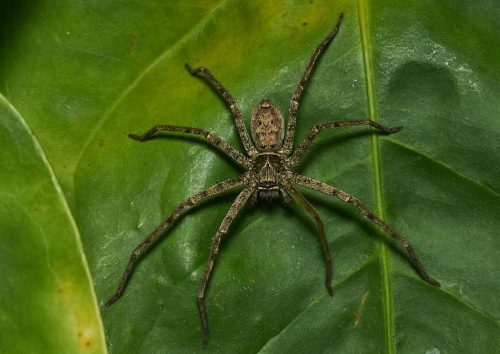
Each of the flat, disc-shaped egg sacs laid by huntsman spiders has more than 200 eggs. The females’ egg sacs are carried beneath their bodies. The flattened bodies of huntsman spiders are well-known for facilitating their huge size and ability to squeeze into unexpectedly small spaces.
Cockroaches are among the many insect pests that these spiders eat. They do not employ webs to ensnare their prey, in contrast to other spider species. Instead, they catch and consume insects with their powerful jaws. They also use their extensive, lengthy gland system to inject poison into their prey’s bodies.
During the mating process, female huntsman spiders produce a pheromone. In order to get females to mate, male huntsman spiders can produce a sound that sounds like vibrations. The speed and even sideways running of huntsman spiders is impressive!
Are Huntsman Spiders in Florida dangerous?
The reason why huntsman spiders are usually found indoors is that they are attracted to the warmth and cover that interior constructions offer. One of these spiders may be hidden behind a wall hanging, under furniture, or even within a cupboard. These spiders also frequently live in garages and closets.
Fortunately, these spiders are not very hazardous despite being very common. They are not violent; they only bite in response to provocation or foot pressure. The bite can hurt, but it is not harmful. Noticeable swelling is frequently the result when it happens.
In the event that a Florida Huntsman Spider bites me, what should I do?
Don’t freak out if you find out you’ve been bitten by a huntsman spider. Usually, these bites don’t cause any harm. They may cause pain, though. In order to lessen discomfort and edema, try elevating the bite site. In case of more severe responses, seek medical attention and apply an ice pack wrapped around the cloth.
Interesting things about the Huntsman Spider?
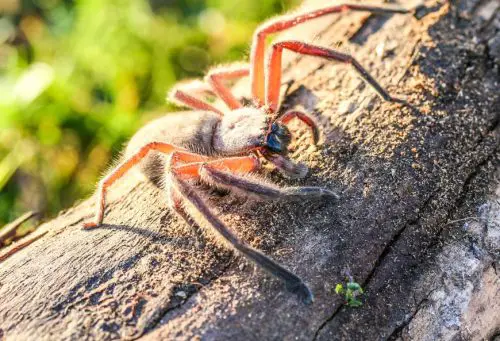
The huntsman spider, often surrounded by myths and misconceptions, presents a world of truth that may surprise many. A common myth holds that these spiders can grow to exceed 6 inches in length. While some Australian species do reach such impressive sizes, the huntsman spider found in Florida does not.
A notable fact about huntsman spiders is their impressive speed. Although it cannot compete with cheetahs, this spider can rush at a speed of more than 31 times its body length per second. To put this in perspective, Usain Bolt, the fastest person, can only move 5.2 body lengths per second. The agility of the huntsman spider is truly a miracle in the world of spiders.
Contrary to the common image of spiders spinning complex webs, huntsman spiders have a different way of hunting. They rely on keen vision and precise vibrations to locate prey, bypassing traditional web-building techniques. This unique hunting strategy sets them apart from other spiders.
In the world of spiders, male huntsman spiders have a special mating strategy. Their goal is to find a virgin woman and to achieve this they look for immature women. The male waits patiently, lingering with the female until she is mature and ready to mate. This behavior shows the complexity of mating rituals in the wild among these fascinating creatures.
Although huntsman spiders occasionally find their way into homes, their natural habitat is beneath tree bark. Peeling back layers of bark can reveal a family of huntsman spiders hidden underneath. This behavior emphasizes their adaptability and the diversity of the environments they inhabit.
People Who Read This Also Read:

